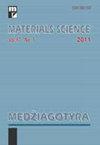New Formation Mechanisms of Pores and Cracks in Micro-arc Oxidation Coatings on 6061 Aluminum Alloy with High Temperature Oxide Prefab Film
IF 0.6
4区 材料科学
Q4 MATERIALS SCIENCE, MULTIDISCIPLINARY
引用次数: 1
Abstract
Prior to micro-arc oxidation (MAO) treatment, a layer of high temperature oxide (HTO) prefab film was fabricated on the surface of 6061 aluminum alloy specimens. The formation mechanisms of the cracks and pores in the MAO coatings were investigated by means of Mg element as the tracer. The results showed that there were several different formation mechanisms for the pores and cracks formed in the MAO coatings as follows. Some of pores were attributed to the residual micro-discharge channels, and the others were attributed to the residual uncovered concave regions locating among the surrounding convex regions. The difference in oxide phase composition caused by the compositional fluctuations in the coating weakened the bond strength at the phase interface and resulted in forming cracks between every two convex regions. Some of cracks were resulted from the solidification and shrinkage of molten coating materials, and the others were resulted from the poor connection between every two convex regions. The surface morphology and the content of each element of the MAO coating were determined using scanning electron microscopy (SEM) equipped with energy dispersive X-ray spectroscopy (EDS).高温氧化预制膜6061铝合金微弧氧化涂层气孔和裂纹新形成机制
其中一些孔隙归因于残留的微放电通道,而另一些则归因于位于周围凸区域之间的残留未覆盖凹区域。涂层成分波动引起的氧化物相组成差异削弱了相界面的结合强度,导致每两个凸区之间形成裂纹。一些裂纹是由于熔融涂层材料的凝固和收缩造成的,另一些是由于每两个凸区之间的连接不良造成的。
本文章由计算机程序翻译,如有差异,请以英文原文为准。
求助全文
约1分钟内获得全文
求助全文
来源期刊

Materials Science-medziagotyra
工程技术-材料科学:综合
CiteScore
1.70
自引率
10.00%
发文量
92
审稿时长
6-12 weeks
期刊介绍:
It covers the fields of materials science concerning with the traditional engineering materials as well as advanced materials and technologies aiming at the implementation and industry applications. The variety of materials under consideration, contributes to the cooperation of scientists working in applied physics, chemistry, materials science and different fields of engineering.
 求助内容:
求助内容: 应助结果提醒方式:
应助结果提醒方式:


